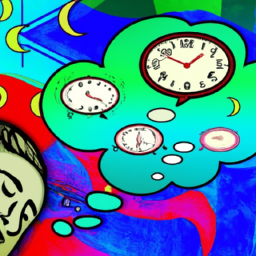I have always been fascinated by the concept of lucid dreaming. The idea of being able to control your dreams and experience any scenario you can imagine is truly amazing.
But when did this phenomenon become mainstream? When did lucid dreaming blow up?
To answer this question, we need to look back at the origins of lucid dreaming. It’s been around for centuries, with early references in the Hindu scriptures and Tibetan Buddhist texts. However, it wasn’t until the 1970s that it became a topic of scientific study and research.
Since then, it has slowly gained popularity, but it wasn’t until the rise of the internet and pop culture that it truly exploded.
Key Takeaways
- Lucid dreaming has been around for centuries, with ancient civilizations and Aristotle recording its existence.
- The scientific study of lucid dreaming began in the 1970s by Keith Hearne.
- The rise in popularity of lucid dreaming can be attributed to the internet and social media, which has led to the creation of online communities and resources, as well as social media influencers and bloggers.
- Lucid dreaming has been referenced in pop culture, such as in the movie Inception and TV show Rick and Morty. It has both advantages, such as improved cognitive functioning, and drawbacks, such as potential interference with sleep disorders. Technological advancements, such as virtual reality headsets, have also contributed to the exploration of lucid dreaming. However, continued research is needed to fully understand and harness its potential benefits.
The Origins of Lucid Dreaming
Now, you may be wondering how you can become a lucid dreamer, but did you know that the concept of lucid dreaming dates back to ancient civilizations? The first written record of lucid dreaming comes from the ancient Greek philosopher Aristotle, who wrote about being aware that he was dreaming.
Many other cultures also recognized the phenomenon, such as Tibetan Buddhists who used lucid dreaming as a way to gain spiritual insight. However, it wasn’t until the 1970s that lucid dreaming began to gain mainstream attention.
Psychologist Keith Hearne conducted the first scientific study on lucid dreaming, which involved a volunteer who signaled she was aware she was dreaming by moving her eyes. This study opened the door for further research and experimentation, leading to the development of techniques for inducing lucid dreams.
And with the rise of the internet, information about lucid dreaming became more accessible, leading to a surge in interest and popularity.
The Rise of the Internet
I personally believe that the rise of the internet has played a significant role in the growth of lucid dreaming.
Online communities and resources have made it easier to connect with others who share a passion for exploring the dream world. Social media has also contributed to the spread of lucid dreaming, with influencers and bloggers sharing their experiences and techniques with a wider audience.
As someone who’s benefited from these online resources, I’m grateful for the internet’s role in making lucid dreaming more accessible and mainstream.
Online Communities and Resources
The explosion of online communities and resources surrounding lucid dreaming is mind-blowing. With just a few clicks, I can access forums, blogs, YouTube channels, and social media groups dedicated to this phenomenon.
These online spaces are filled with people who share their experiences, techniques, and insights on how to achieve lucidity in dreams. I’ve learned so much from these platforms – from how to keep a dream journal to how to perform reality checks during the day.
I’ve also connected with other lucid dreamers from all over the world, and it’s amazing to see how this practice brings people together. The influence of social media has been particularly significant in spreading awareness about lucid dreaming.
Many influencers and content creators on platforms like Instagram and TikTok have shared their experiences and tips, making this practice more accessible to younger audiences. However, this exposure has also led to some misconceptions and sensationalism about lucid dreaming.
It’s important to approach these online resources with a critical mind and to seek out credible sources of information. Nonetheless, I’m grateful for the wealth of knowledge and support that I’ve found in the online lucid dreaming community.
The Influence of Social Media
With the rise of social media, lucid dreaming has become more accessible to younger generations through influencers and content creators sharing their experiences and tips.
Platforms like Instagram and YouTube have allowed individuals to share their personal journeys with lucid dreaming and provide helpful tips on how to achieve it. Additionally, hashtags such as #luciddreaming and #dreamcontrol have made it easier for users to find information about the topic.
The influence of social media has also given rise to online communities dedicated solely to lucid dreaming. These communities offer a space for individuals to connect with others who share the same interest and provide a platform for discussion and support.
Many of these communities also offer resources such as guided meditations and lucid dreaming techniques. Overall, the accessibility of lucid dreaming through social media has played a significant role in the popularity of the practice among younger generations.
As a result, it has become a topic of interest in pop culture and mainstream media.
Pop Culture and Mainstream Media
You might remember seeing lucid dreams in popular films and TV shows like Inception and Rick and Morty, indicating their rise in mainstream media. This exposure has played a significant role in the widespread interest in lucid dreaming. People are becoming more curious about this state of consciousness and are eager to explore its possibilities.
To further understand the impact of pop culture and mainstream media on lucid dreaming, let’s take a look at this table:
| Pop Culture References | Description | Effect on Public Interest |
|---|---|---|
| Inception | A film about a group of people who enter dreams to extract information | Increased awareness and curiosity about lucid dreaming |
| Rick and Morty | An animated series about a mad scientist and his grandson who travel through different dimensions and realities | Encourages experimentation and exploration of the unknown |
| Doctor Strange | A superhero film about a neurosurgeon who gains mystical abilities | Presents lucid dreaming as a way to access hidden powers and abilities |
As we can see, these popular references have had a significant impact on the public’s perception of lucid dreaming. However, it’s important to note that there are also potential risks and benefits associated with this practice.
The Benefits and Risks of Lucid Dreaming
Exploring lucid dreaming can offer both advantages and potential drawbacks. On one hand, being able to control your dreams can be a thrilling and empowering experience. It allows you to confront your fears, try out new experiences, and even improve your cognitive functioning. Some studies have suggested that lucid dreaming can promote problem-solving skills, creativity, and improved memory consolidation.
However, there are also potential risks associated with lucid dreaming. For example, some people report feeling exhausted after lucid dreaming, as it can be mentally taxing to maintain control over your dreams. Additionally, there’s the possibility of developing sleep disorders or experiencing sleep paralysis, a condition where you’re unable to move or speak upon waking up.
Despite these risks, many people still find the benefits of lucid dreaming to be worth exploring. As we look towards the future of lucid dreaming, it’ll be interesting to see how technology and research continue to shape our understanding of this phenomenon.
The Future of Lucid Dreaming
I’m excited to talk about the future of lucid dreaming, as it’s a topic that has captured my imagination for years. Two key factors that will shape the future of lucid dreaming are technological advancements and virtual reality.
As these technologies continue to evolve, they’ll enable us to create more immersive and realistic dream environments. Continued research and exploration will also help us better understand the science behind lucid dreaming and how we can use it to improve our lives.
Technological Advancements and Virtual Reality
With the rise of cutting-edge technologies like virtual reality, lucid dreaming has become a popular subject in the realm of immersive experiences. Virtual reality (VR) can simulate any environment and can be used to create a dream-like state that can be explored and manipulated. This has opened up a new avenue for lucid dreaming research and exploration, and has allowed people to experience the benefits of lucid dreaming without having to rely solely on their own mental abilities.
One of the most exciting advancements in lucid dreaming technology is the development of VR headsets that can track eye movements. This allows for more accurate and responsive dream control, as the dreamer can simply look at objects or locations within the dream to interact with them. Additionally, there are apps and programs being developed specifically for lucid dreaming, which use audio and visual cues to help induce lucidity and maintain dream control. With these new technologies, the possibilities for exploring the depths of lucid dreaming are endless, and it will be exciting to see what advancements will come in the future.
Continued research and exploration into lucid dreaming is essential for understanding the full potential of this phenomenon. With the help of new technologies and research methods, we can gain a deeper understanding of the science behind lucid dreaming and how it can be used to improve mental health, enhance creativity, and even treat certain mental illnesses. As the field of lucid dreaming continues to develop and expand, we can look forward to even greater advancements and discoveries in the future.
Continued Research and Exploration
As I mentioned earlier, technological advancements and virtual reality have played a significant role in the rise of lucid dreaming. However, that’s not the only reason why lucid dreaming has blown up in recent years.
Continued research and exploration have also contributed to the growing interest in this phenomenon. Scientists and researchers have been studying lucid dreaming for decades, and their findings have been instrumental in increasing our understanding of this mysterious state of consciousness.
For example, studies have shown that lucid dreaming can be used to treat anxiety, improve problem-solving skills, and even enhance creativity. As a result, more and more people are becoming interested in exploring their own dreams and learning how to become lucid dreamers themselves.
Furthermore, the internet has made it easier than ever before for people to connect with one another and share their experiences with lucid dreaming. There are countless online communities and forums dedicated to this topic, where people can share tips, tricks, and techniques for achieving lucidity in their dreams.
All of these factors have contributed to the continued growth and popularity of lucid dreaming, making it one of the most fascinating and exciting phenomena of our time.
Frequently Asked Questions
How do you induce lucid dreaming?
To induce lucid dreaming, I exaggerate my reality checks throughout the day, focusing on my surroundings and questioning if I’m dreaming. I also keep a dream journal and visualize my desired dream before sleep.
What is the difference between a lucid dream and a regular dream?
A lucid dream is when you become aware that you are dreaming while still in the dream. This allows you to control the dream and do things that are impossible in waking life. Regular dreams are not conscious and you have no control over them.
Can anyone learn to have lucid dreams?
I’ve read that anyone can learn to have lucid dreams. By practicing reality checks, keeping a dream journal, and using techniques like MILD or WILD, one can increase their chances of experiencing this exciting phenomenon.
Is lucid dreaming dangerous in any way?
Lucid dreaming can be dangerous if not done properly. It can lead to sleep deprivation, false memories, and even sleep paralysis. However, with proper techniques and precautions, lucid dreaming can be a safe and rewarding experience.
Can lucid dreaming be used for therapeutic purposes?
Lucid dreaming has been used for therapeutic purposes, such as overcoming nightmares and anxiety. It allows for a safe space to confront and work through personal issues. It’s a game-changer in the world of mental health. Plus, it’s a dream come true.
Conclusion
As I sit here, reflecting on the history of lucid dreaming, I can’t help but wonder what the future holds for this fascinating phenomenon. Will it continue to gain popularity and become a mainstream practice? Or will it fade into obscurity, only to be remembered by a select few?
One thing’s for sure, lucid dreaming has come a long way since its origins, and it’s become a topic of interest for many people around the world.
But as with any powerful tool, there are risks involved with lucid dreaming. It can be a double-edged sword, providing incredible benefits such as stress relief and increased creativity, but also potentially causing negative side effects like sleep paralysis and nightmares.
Only time will tell how society will choose to approach this complex practice. The suspense is palpable, and I can’t help but imagine what the future holds for lucid dreaming.










